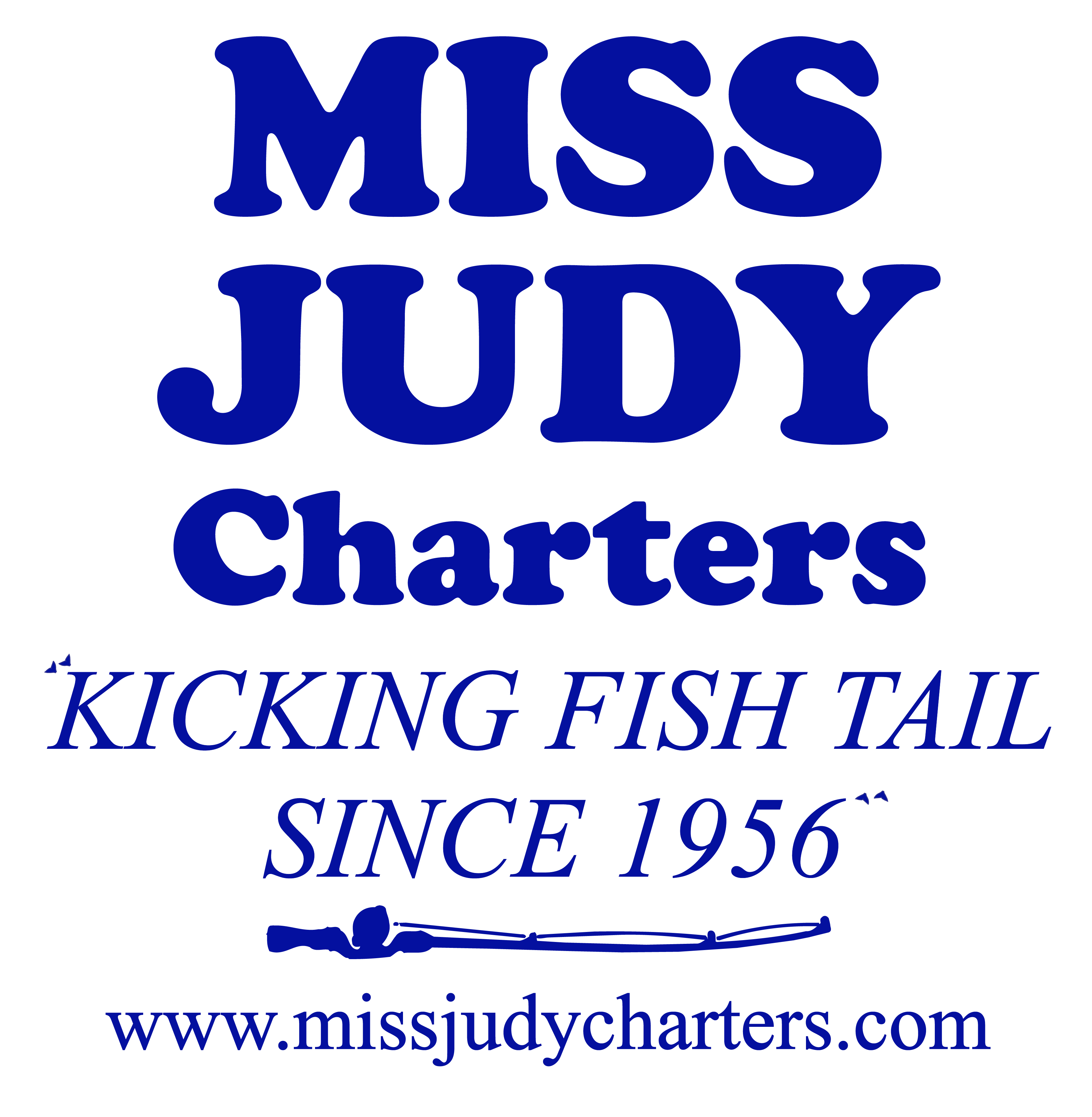CAPTAIN JUDY HELMEY
“Kicking Fish Tail Since 1956”
124 Palmetto Drive
SAVANNAH, GEORGIA 31410
912 897 4921 912 897 3460 FAX
Captain Judy’s email fishjudy2@aol.com
912 429 7671 Captain Judy’s cell
December 2023 Captain Judy Inshore offshore monthly fishing report, Triple Ledge story, and dates for the inshore/schools!
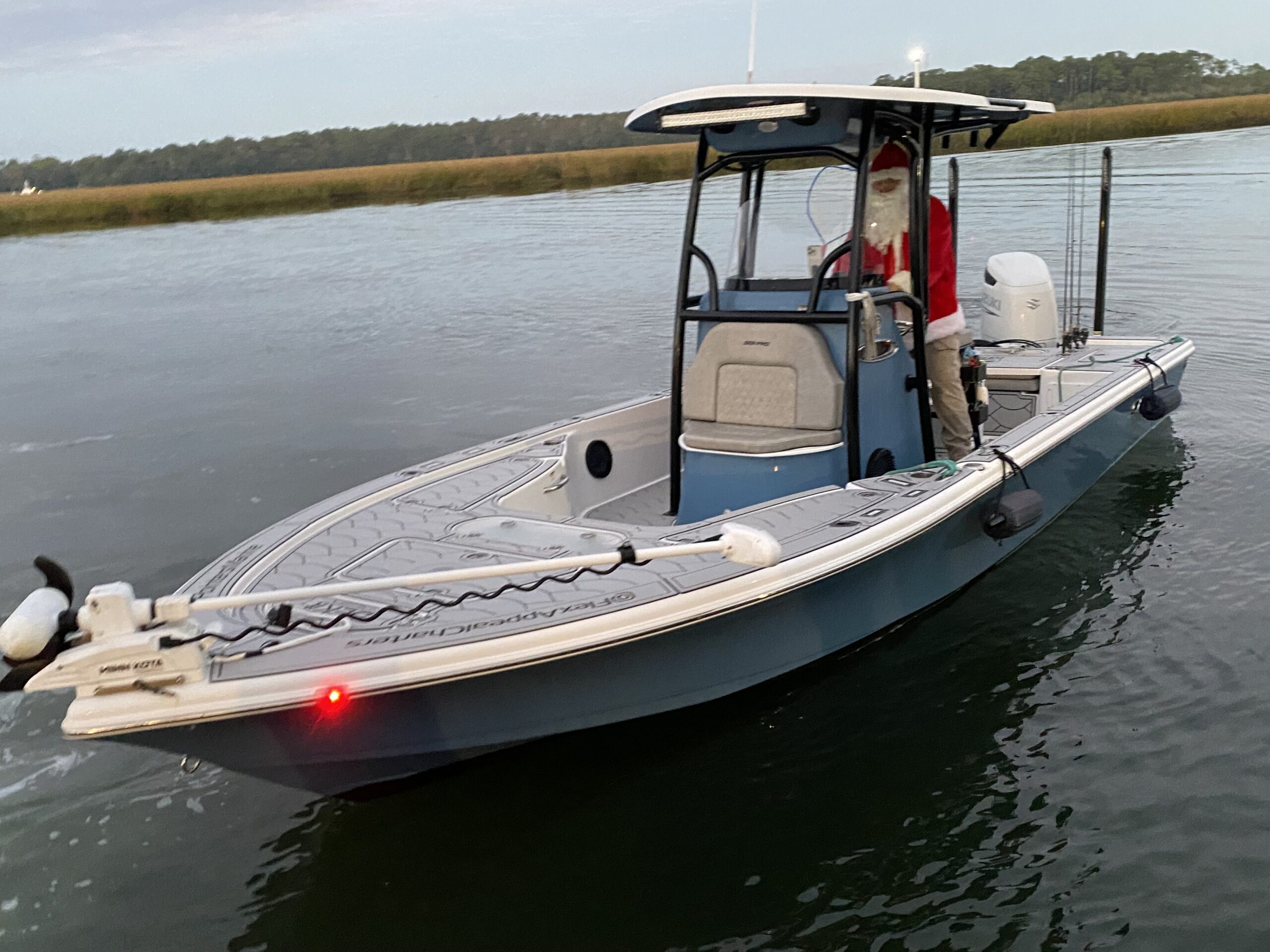
Captain Garrett Ross of Miss Judy Charters was nice enough to loan Santa Claus his boat for the day! Hello Santa Claus!
There is one thing that I can say about the month of December when it comes to catching fish and that is “it can happen!” During this time all fish from spotted sea trout to flounder to red fish are doing what they do best and that’s bulking up for those unpredictable but fast on the way cold weather patterns. It’s also a great time to be a weather watcher. Normally the inshore bite will “turn on big time” when there is an approaching cold front. The fish usually feed hard at about 18 to 24 hours before the big weather change takes place. The best natural bait is going to be live shrimp and the best artificial baits are those that imitate them. Live shrimp will work under popping or traditional adjustable corks or just plain naked meaning using a hook only. Most spotted sea trout, red fish, and flounder will take a chance on a shrimp even if it does look a little fishy. From a fish’s point of view, the shrimp is easy to catch, easy to eat, and easy on the stomach. And once you get the bite going on the live or fresh dead shrimp it’s easy to change to artificial such as DOA’s. When it comes to getting the red fish bite I suggest pitching copper penny, baby bass, or ice flukes made by Strike King (ZTOO) rigged weed less, cast right into the grass. When using artificial bait during cooler water times, please remember to work your lure slower than normal. The reason being is everything is moving a bit slower, and this includes the bait and those that eat them. These are old school suggestions that have been working for many years.
When you can’t purchase or catch your own live shrimp there is another bait to consider. The old standby mud minnow is easy to catch, and it is classified as one of those hardy baits. It is listed as the second on the best bait to use scale. But I can guarantee you that 9 times out of 10 if you can’t find shrimp neither can the fish. A single mud minnow works great and is usually good several times even after hits, misses, or catches. If one minnow lipped hooked either under a popping or adjustable cork doesn’t work, I suggest adding another one. Using doubled up baits can turn an unlikely bite on.
Here are two tips you can use…when the water gets cooler it is much clearer, which means if you can see the fish, it most likely can see you too! When approaching your fishing spot do so “slowly!” I suggest offering the least amount of noise and impact. Once arriving slowly drop your anchor quietly as possible.
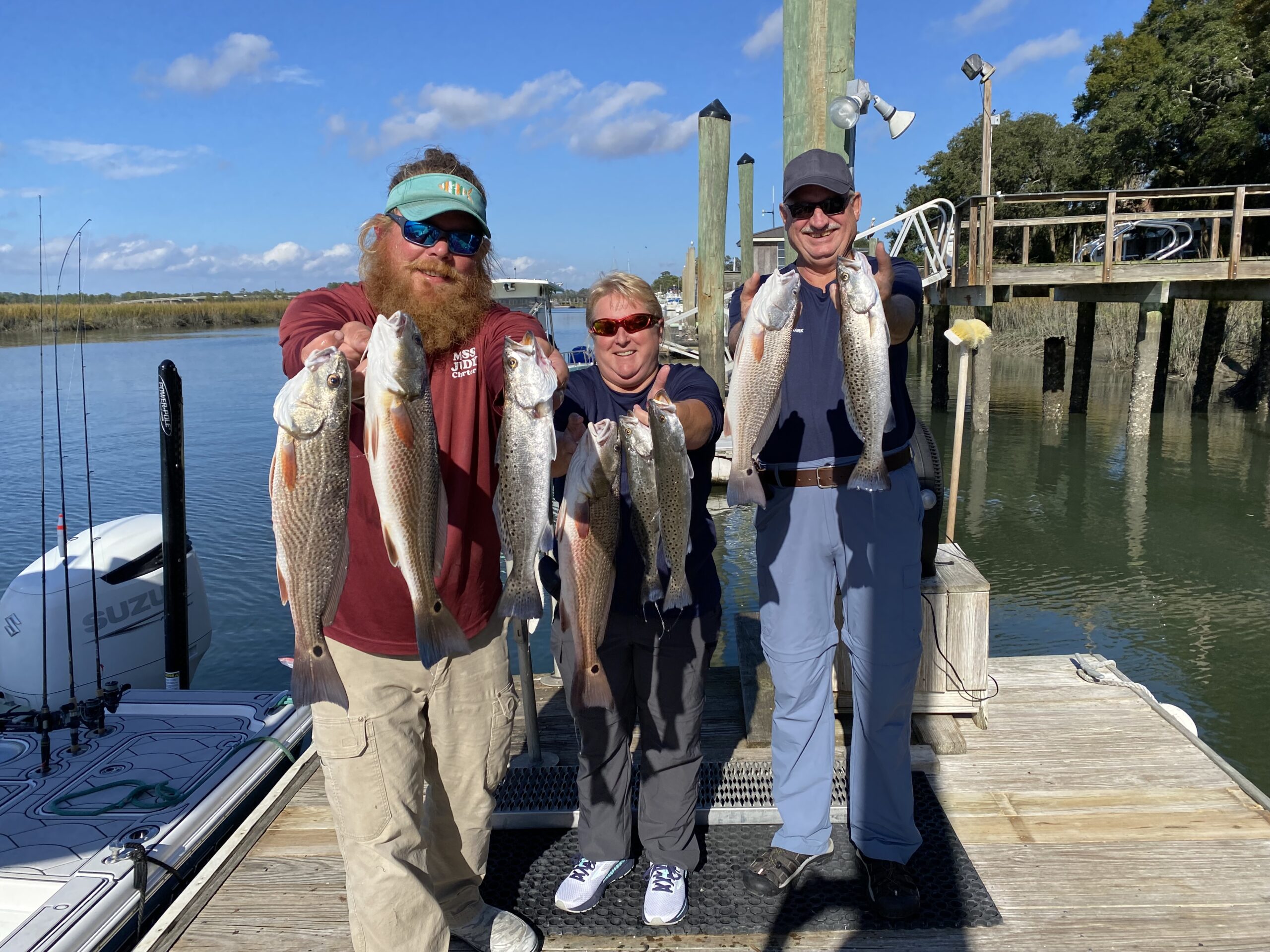
Captain Garrett Ross of Miss Judy Charters took Ila and Mark Johnson on an inshore fishing trip. Now, how many times do that fish a year with Captain Garrett? Well, I believe, it comes to about 4 fish days a year! Yahoo times two!
2024 Captain Judy’s Inshore/Offshore Fishing Clinics
February 16, 2024 Friday, February 17, 2024 Saturday and February 18, 2024 Sunday
Inshore/offshore boats in the water
$200.00 per person for inshore
$200.00 per person for offshore
Morning departures
Time: 8:00AM till12:00 NOON
Place: Miss Judy Charters dock
202 Wilmington Island Road, Savannah, Georgia 31410
912 897 4921 for more details!
We offer classes on the water in the boats! Sign up soon!
(Miss Judy Charters 912 897 4921or email me fishjudy2@aol.com)
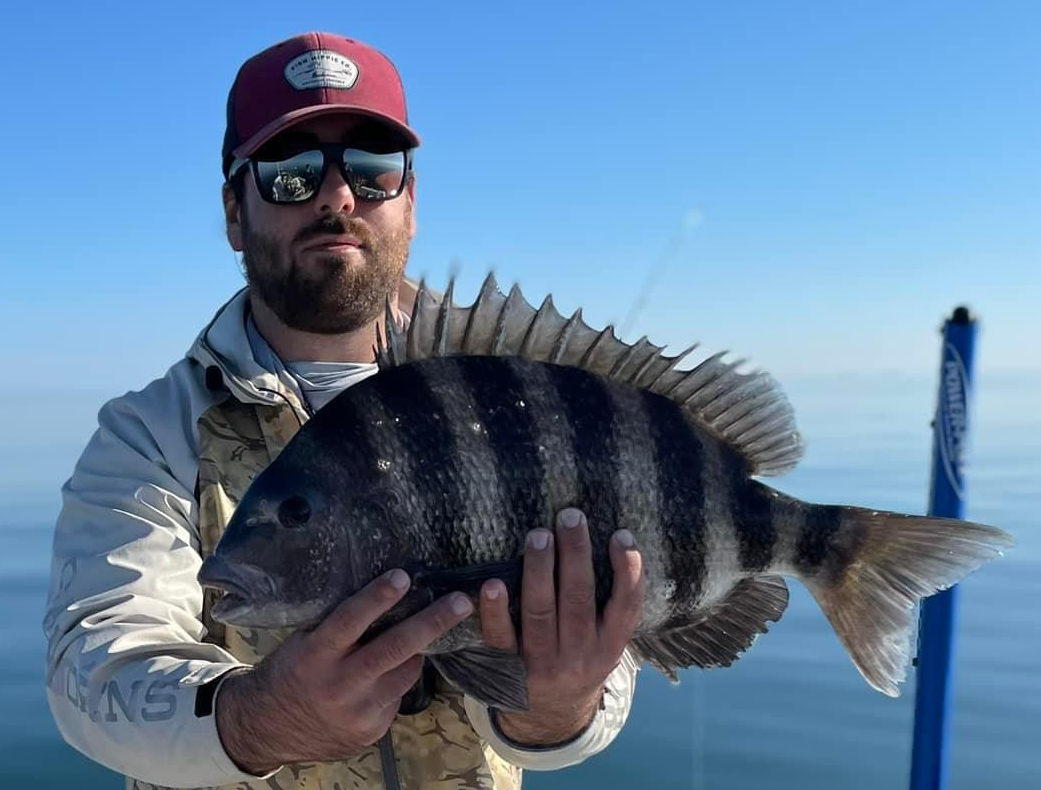
Captain Justin Rahn of Miss Judy Charters wants to remind us that the cold water inshore/offshore sheepshead bite has started! And what is said about the meat taken from the old sheepshead? It is called “Poor man’s crab meat!” It’s time of book a trip! 912 897 4921 office!

Captain Jake Ross of Miss Judy Charters took Mr. Cooter to do a little inshore keeping and lots of inshore releasing. We get to see Mr. Cooter about 6 times plus year! And it is always a pleasure for sure! What is on the fish cleaning table? The prefect size grilling with the skin on red fish also know as red drum! And of course, they could not come back to the dock without one sheepshead! Once cooked properly, make one heck of a stew for two!
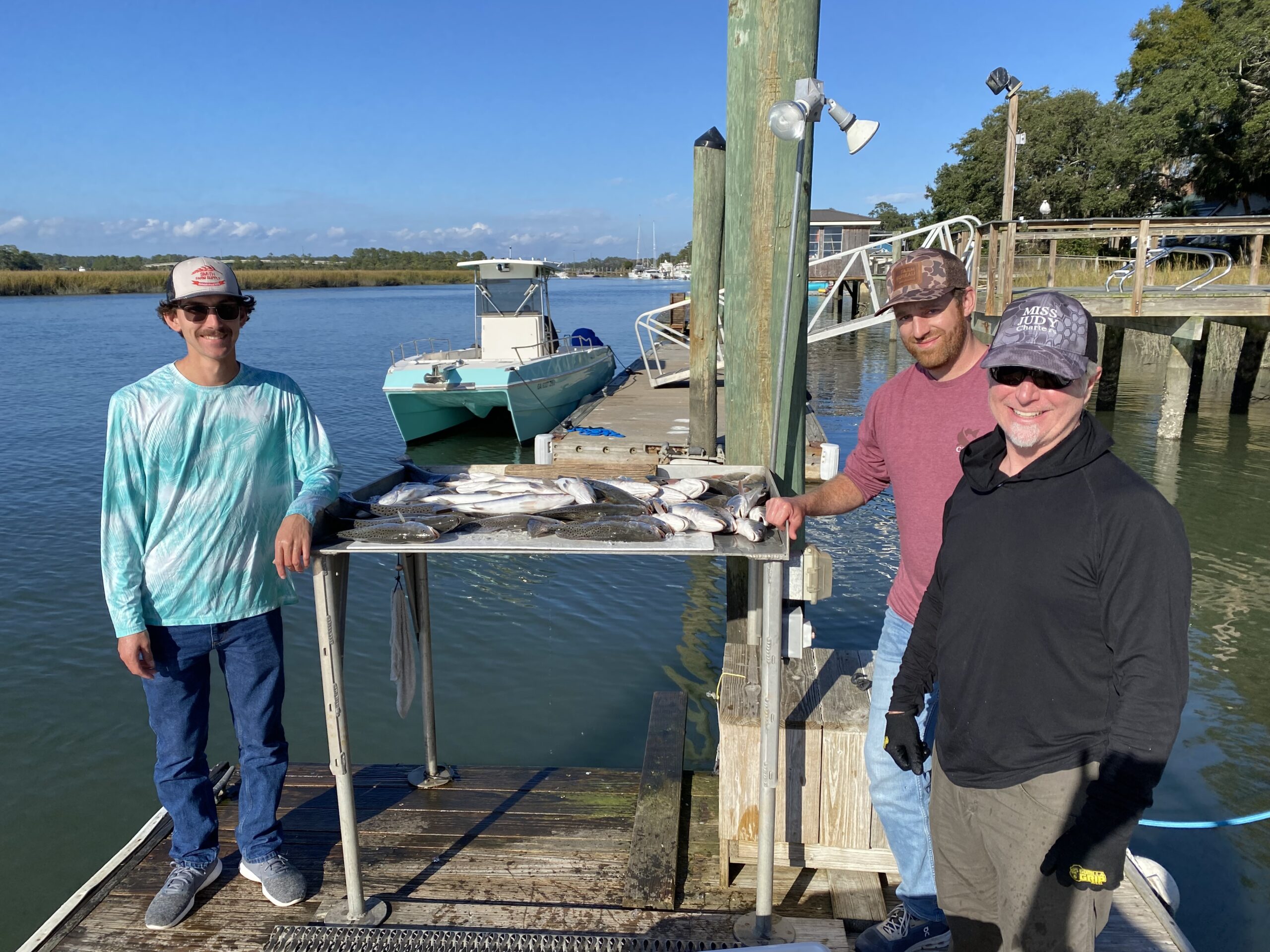
The fish cleaning table is covered with a big mess of just caught fish! Who showed them the way? Captain Matt Williams of Miss Judy Charters! What is left to say? This group is going to be eating fish for a while! It might be fried, BBQ, broiled, baked grilled, makings for fish tacos, blackened, and I think you get the point that I am trying to make!
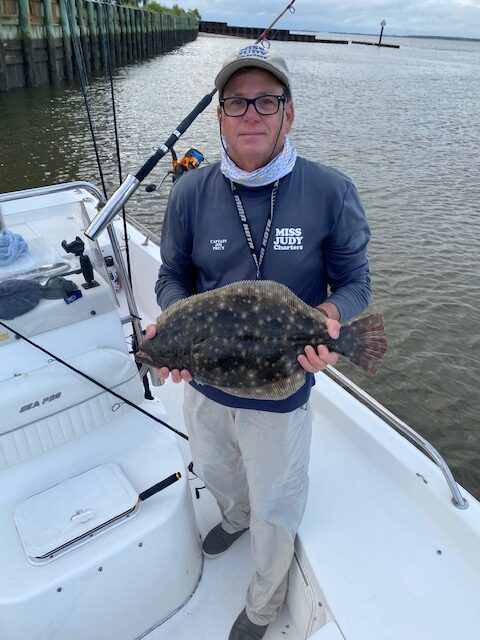
Captain Jim Price of Miss Judy Charters is still some of these fish! Nowe we all know that the old flounder is only called real time by-catch during the cold-water times. However, when you go fishing, especially in saltwater, you never know what might bite your hook!
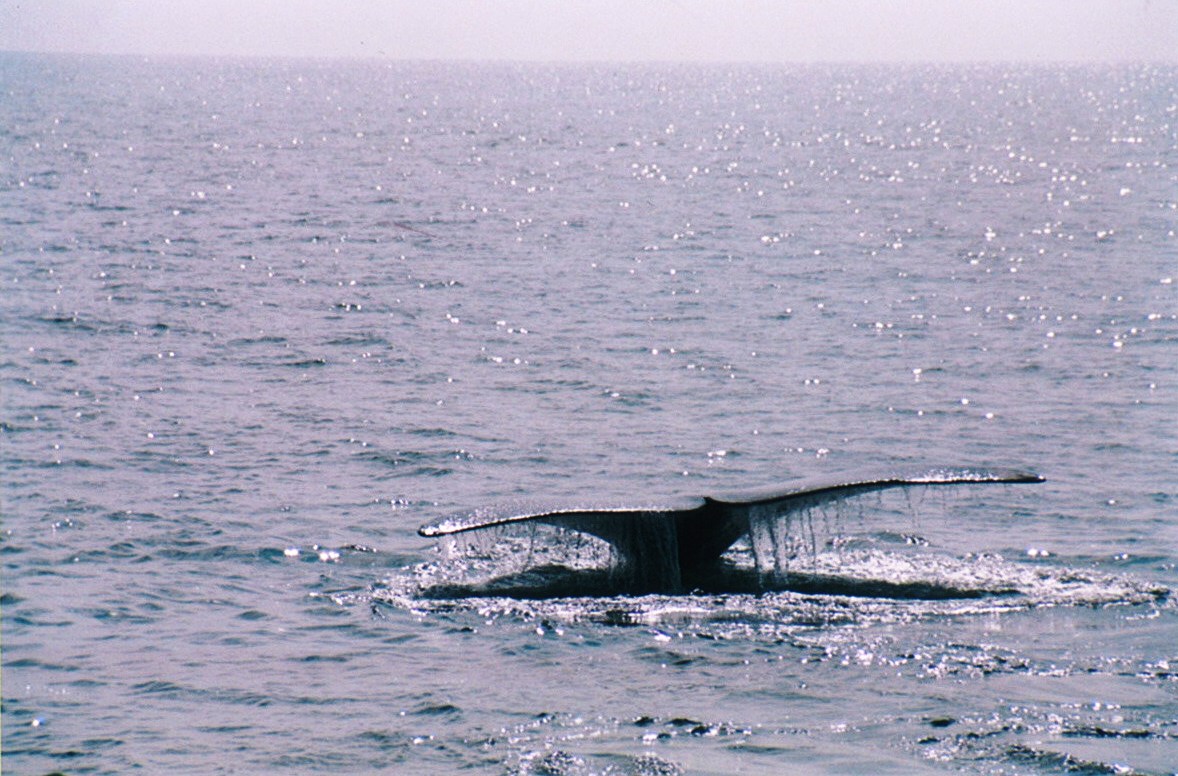
Photo by Captain Judy Helmey
I will never forget this picture as long as I live. I was offshore about 8 miles and I watched as a right whale was making way. I grabbed my camera and started clicking away. The end result was this. The prefect picture of a right whale’s tail with the prefect background silhouette! I have always said, “I am not a trained writer nor a photographer!” However, the ocean has offered many things and thoughts to practice on. As we all know, practice makes the prefect situation!
December is the month where it is possible to see right whales and great white sharks. I always ask my customers if they see anything unusual on the surface to please point it out to me. When I am making my way offshore, I always keep a good look out. Right whales are slow moving creatures! If you find yourself close to a right whale, whatever you do don’t put your boat in gear. Just remain calm and as quickly as they arrive, they should leave. However, the good news is that there are no rules that specify that you can’t take pictures. Please take all you can, because what is happening to you doesn’t happen to you but a few. The very next thing that you need to do is to contact the coast guard or have someone relay coordinates of your whale encounter. The reason is very simple, but very important, “it could save their life!” The coast guard will then contact proper sources so that coordinates can be sent to boats/ships that are navigating around the sighting. Right whales, especially when swimming with their calves will quite often lay on the surface for long periods at a time. This normal act unfortunately can put them right in the path of large vessels or should I say, “In harm’s way!” For right whales that you happen up on please keep your distance. You are required by law to stay the distance of at least 500 yards. The reason being there aren’t that many of these precious mammals left. A collision with one might cause serious injury or death to the whale. There are not that many left in the North Atlantic Ocean. Once again when you spot a right whale please contact the Coast Guard on Channel 16 of your marine radio.
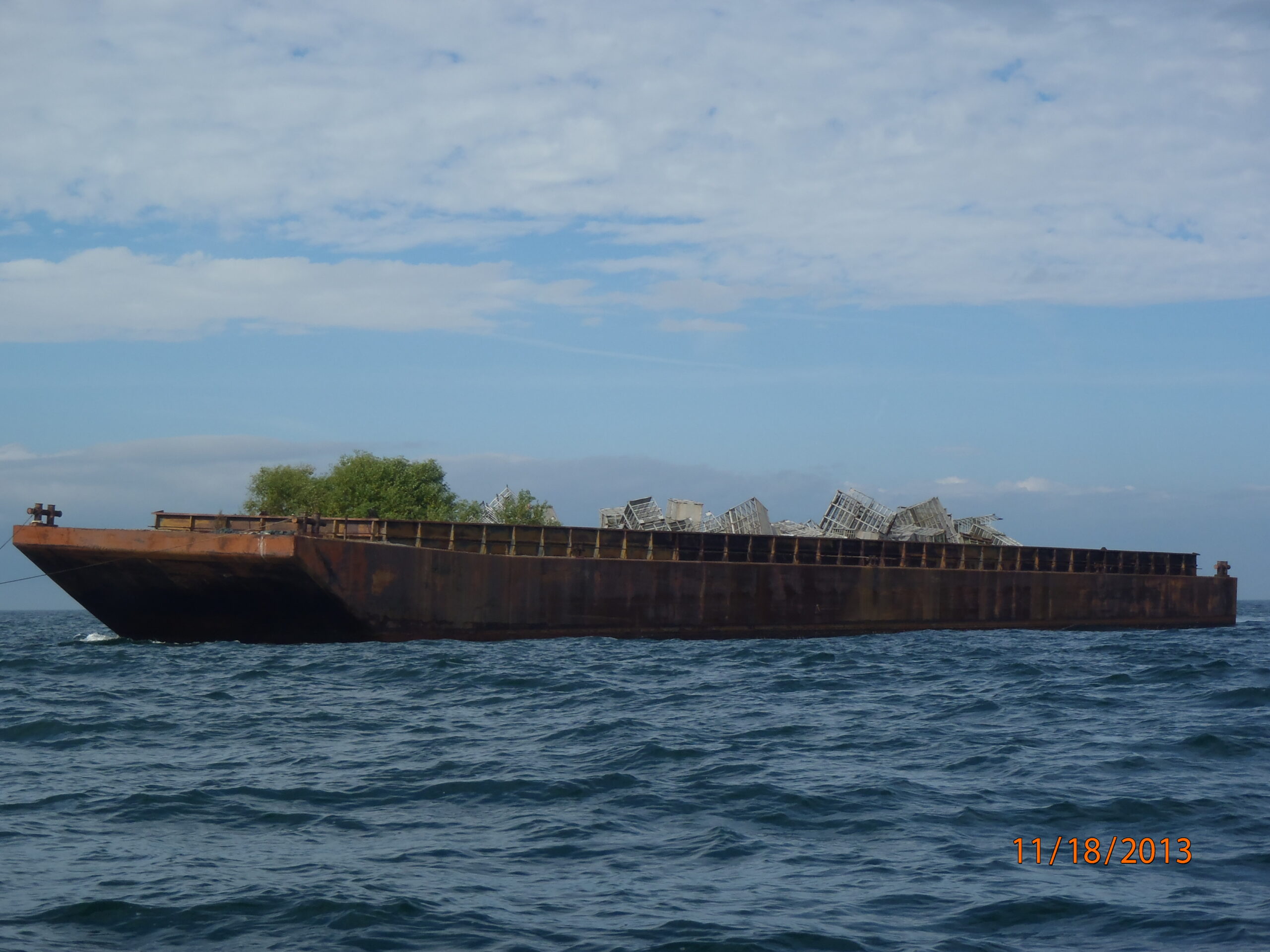
The 254-foot-long hopper barge is loaded down with 330 chicken cages. (Donated by Claxton Chicken Company) This barge has been sitting in the back river for about 10 years! There are several full-grown Chinese tallow trees located on the barge’s bow. Another added up right thing for fish to accumulate. Just so you know….Georgia artificial reef program covers about 52 square miles and consists of 20 offshore reefs, two beach reefs, eight navy tactical air crew training system towers. This barge joined a host of New York city subway cars, M60 battle tanks, and other steel-hulled vessels. And what does this mean to the Georgia’s coast mostly barren and sandy bottom areas? These additions offer a wealth of underwater hotels and motels for fish to stay and visit. This all boils down to is some fish will become residents (stayers) and others (movers) will be non-residents! Also now you know what’s down under! This barge was placed/sunk at the KC artificial reef. I call it the Chicken Coup!
3150.389N 8046.533W coordinates for Hopper Barge with 330 chicken cages
Now, I am sure you are not going to believe this one..I had a customer ask me what do we feed the chickens?
For some really great information on Georgia’s offshore reef do here:
https://coastalgadnr.org/sites/default/files/crd/Reefs/Guide%20to%20Georgia’s%20Offshore%20Artificial%20Reefs%20Jan2022.pdf
Offshore Artificial Reefs
December is a grand month for those fishermen that love a light tackle fishing experience. Artificial reefs are holding sheepshead, black drum, trophy red fish, flounder, and cold-water sharks. Fish put these areas on their list of places to school up to bulk up for winter migrations. The best baits for Sheepshead, black drum, and trophy red fish are going to be the purple back fiddler, juvenile rock crabs, and green mussels. Small pieces of shrimp will also work. These fish love anything wrapped in a shell or the meat that is removed from them. Flounder are known for situating themselves on the outskirts of the structure while waiting for that prefect meal. The best baits for the old flounder are jumbo mud minnows or small sand perch placed on a Carolina style bottom rig. Placement of this bait is simple, cast to the outskirts of the structure, set drag to medium, and place rod in holder. Another baiting up method for flounder is to take a 3 ounce jig head 9https://nuts-and-bolts-of-fishing-boating.myshopify.com/) which is still my favorite “old school type” jig!) bait it with live finger mullet or any live bait that is about the size of a cigar or strip bait and put it on the bottom. -Or you can butterfly a small fish, which when introduced back into the water, offers up two working flowing tails. The best thing about jig head fishing is that you can move your bait along the bottom, and it imitates a small fish. When a small fish is skirting close to the bottom it forms somewhat of a head turning sandstorm. And a fish knows this, because they have been there and ate things doing this sort of thing before. When you get a hit whatever you do don’t try to set your hook, because flounder are known for being slow bait takers. In other words, give them time to eat! Old time fishermen used to say that before you set the hook count like this 1001, 1002, 1003, 1004, 1005, 1006, and then set the hook. If you miss the set, I suggest quickly dropping your bait back and letting it just sit. It is going to be a waiting game to see if the fish will give it another try.
If sharking is on your mind and if you are looking for an unbelievable fight of grand portions, I suggest bringing along some squid or cutting up some freshly caught fish. Another great bait when targeting shark is going to be belly strip cut from a sheepshead. All you must do is cut the belly out of the fish leaving you the best part to eat, hook it up, and put it on the bottom. (Removing the belly only from any fish still allows it to be intact meaning tail and head still allowing for any official measuring.) It’s best to try to place this bait as far on the outskirts of the structure as possible. In other words, cast these baits as far as you can from where you are anchored. Please always check state and federal regulations for any closers and size limit.
The artificial reefs located in less than 60 feet of water used to hold the interest of large numbers of summer trout. However, this has changed a bit. We don’t catch a lot of summer trout aka weak fish like we used to, but when we do, they are on the large size! (meaning 20 inches plus size range one size feeds two!) The best bait is going to small pieces of cut fish, squid, and cigar minnows.
Way back when, it was known fact that black sea bass migrated into the near shore artificial reefs during the colder water times. However, it seems that over the years this fish’s migration pattern has changed. What does this mean? Well, when the water temps drop large schools of black fish find 70 to 80 feet of water their sweet spots for bulking up. So therefore, I have noticed that any isolated live bottom areas or grown over debris fields do hold the feeding interest of these fish.
With the gag grouper season closed until May 1, 2024, you can catch, but you can’t keep them! So therefore, practice catching and releasing is going to be in your future when targeting this fish!

Captain Judy’s Domain and some areas around it!
I have spent way over 50 years searching for fish in these areas. And here’s the thing about that: Time flies much too fast! Just so you know: When the year of 2024 rolls around… I will be celebrating my 60’s year of taking charter customers fishing! The first 10 years of my fishing time was spent chasing fish at the old Black Fish Banks, which is now called South Carolina’s Hilton Head Reef 61177.7 45549.7 LORAN coordinates 3159.948 08035.928 GPS coordinates.
Savannah Snapper Banks
Bottom fishing in 90 to 100 feet of water can be very interesting because you never know what you might catch. The best bottom fishing baits are going to be small pieces of squid, cut fish, and fresh or frozen cigar minnows. If you happen up on a school of baits meaning schooling cigar minnows or Spanish sardines, I suggest getting out a Sabiki bait rig and give it a try. These types of baits are known for triggering a fish bite that might not have existed! And believe me fresh dead/halves of minnows in most cases work great!
All of these baits bring the attention of black sea bass, vermilion snapper, white grunts, porgy, trigger fish, and other colorful bottom biters. If you are looking for a bigger bottom bite, I suggest dropping a lipped hooked ruby red lip, sand perch, vermilion, or rock bass down to the bottom. These baits attract amberjack, grouper, and red snapper, which by the way come in extra-large sizes!
Catch and release only when targeting grouper, genuine red snapper, and red porgy also known as Charleston Snapper!
Before heading out I always suggest checking with http://www.safmc.net/ for current offshore regulations.
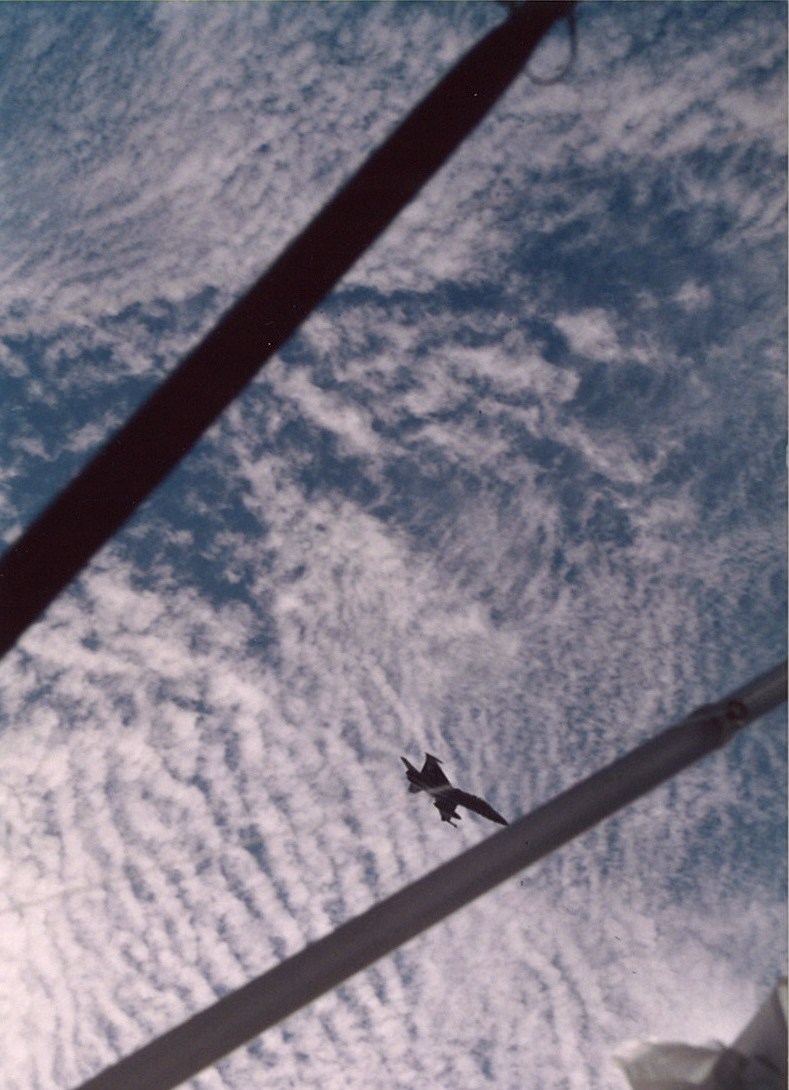
US fighter jet giving us a wing tipping hello and a quick goodbye! While in the ocean it was not unusual for a jet to jet by! The fact of the matter is customers loved it. And when the pilot tipped their wings, well, we would all clap and yell! One day while the jets were jetting around, they started playing war games. One jet was pulling what we called a drone, and the other jet was trying to shoot it. Well, shooting it was not a problem for sure. When these drones were hit leftover parts fell. And of course, we all tried to get the downed drone before they sunk into the abyss. I never got that close enough, but a charter captain friend of mine did. Captain Don was up front and present upon the splash down. He scooped the drone up before it sank! We all asked, “What is it made of? Captain Dan replied, “Rocket Material!” What is classified as rocket material?
Gulf Stream
This is one of those fishing opportunities that most fishermen don’t even think about. Heck, with the holiday season in “Full Throttle” it’s understandable! However, if you get the chance and want to make the run to the blue water off the Georgia coast this would be a great time to find yourself involved in a strong line stretching ordeal! Our black fin is normally on the Wide-Open mode! And this is one fish that can offer you a strong fight. You can find these fish holding over the ledges in 180 to 250 feet of water or you might just happen to find a school holding in the upper water column that has rounded up a school of bait. The best lures that fit into what is called old school tools are “Cedar Plugs” pre-soaked in menhaden oil. I am not talking about colored cedar plugs. I am suggesting the actual plug that is made with cedar showing not the ones that are painted. These plugs absorb the menhaden oil while holding it longer when trolling producing “lots of happy fishy trails!” It is a known fact that menhaden oil attracts the attention of fish. I call it the “there is always a bigger fish in the sea effect.” The reason being is smaller fish are attracted by the oil as well as the larger ones. We all have something in common the fish want to eat, and the fishermen want to catch!
For those fishermen that have to troll with real bait I suggest Ilander Trackers rigged with dink ballyhoo baits. The trick here is to rig the Ilander Trackers with 60-pound test fluorocarbon and small, short shank extra strong 4/0 to 5/0 hooks. This style of rig works well when rigging with dink (small) ballyhoo.
Back in the old days, I always liked to use pink 50-to-60-pound test Ande fluorocarbon line as my leader of choice. And I am sure you want to know why? While rigging one day I happened to drop the leader onto the deck. And I had a hard time finding it for sure! So therefore, it rightfully gained its name of disappearing pink, because that is exactly what it did! My theory was when targeting blue water fish which sports large eyes that the leader was very easy to follow. This situation takes the super strike bite off the table. With the disappearing Ande pink leader in the mix a fish’s first look is going to be on the bait not what’s holding it there!
For those fishermen that love to do a little jigging, once you find the tuna, drop your lure to this depth and work it. The best deepwater jigs are those butterfly type designs from 3 to 6 ounce. For the best jigging results, I suggest using braid as main line and a fluorocarbon leader above the jig. It’s time to go, because now you know!
Little Miss Judy’s Believe It or Not!
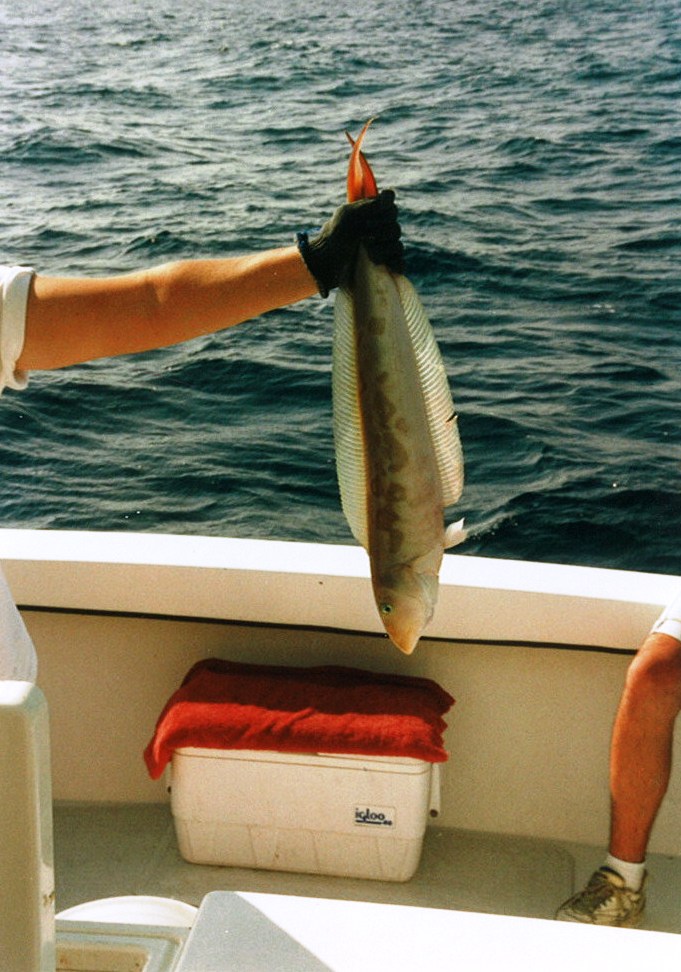
Sand Tile
When we started catching these fish we were in for a very big surprise. There are some big surprises when it comes to this fish’s attitude…it will bite you, it is strong, it looks like a snake, and acts like one too.
The Most Famous Triple Ledge Story!
My way: 61052.7 45080.00 LORAN
Or Everyone else’s way: 3116.769 7952.069 GPS
Gulf Stream Memories!
I had heard about the Triple Ledge all my life. I never thought I would ever get the opportunity to fish in this area, much less get to know so much about it. Before I started fishing in real time blue water I always heard about the Triple ledge, the Deli, the Sow Pen, the B-liner hold, the south ledge, and the Charleston Bump. After I started fishing blue water (1994) I fished all of the above, but I added the shrimp boat, 300-foot hang, Mammoth Hole, (430 hole) 226 Hole, the mountains, the 944 ledge, the upwelling, the Bird, 380 hole, the big airplane, and if I think of anymore I will add them also. As with all the spots/ledges that I fish at the Savannah Snapper banks and blue water their names given have serious meaning for sure.
I bet I have hundreds of pictures of people and fish, which were taken while fishing in all these areas. And I am sure that when you look at the pictures it just looks like lots of water, fishers, and fish. However, these spots didn’t ever look the same to me. I guess I was always thinking about all the fish and bottom that was under all that beautiful blue water! It was a serious gift to me for sure! All spots listed above had meaning and offered lots of catching value for sure!
The Triple Ledge was a football field size area that had the capabilities of offering some continues catching opportunities. It just didn’t have one ledge it had three, which boiled down lots of possible fish catching time in one area, and it was harder wearing your welcome out. You would only get about 30 minutes of effective fishing time from areas that only had one ledge. After pulling at different angles over the ledge the fish started to know that you were not supposed to be there in the first place and would start to scatter. When the fish scatter the bite goes right along!
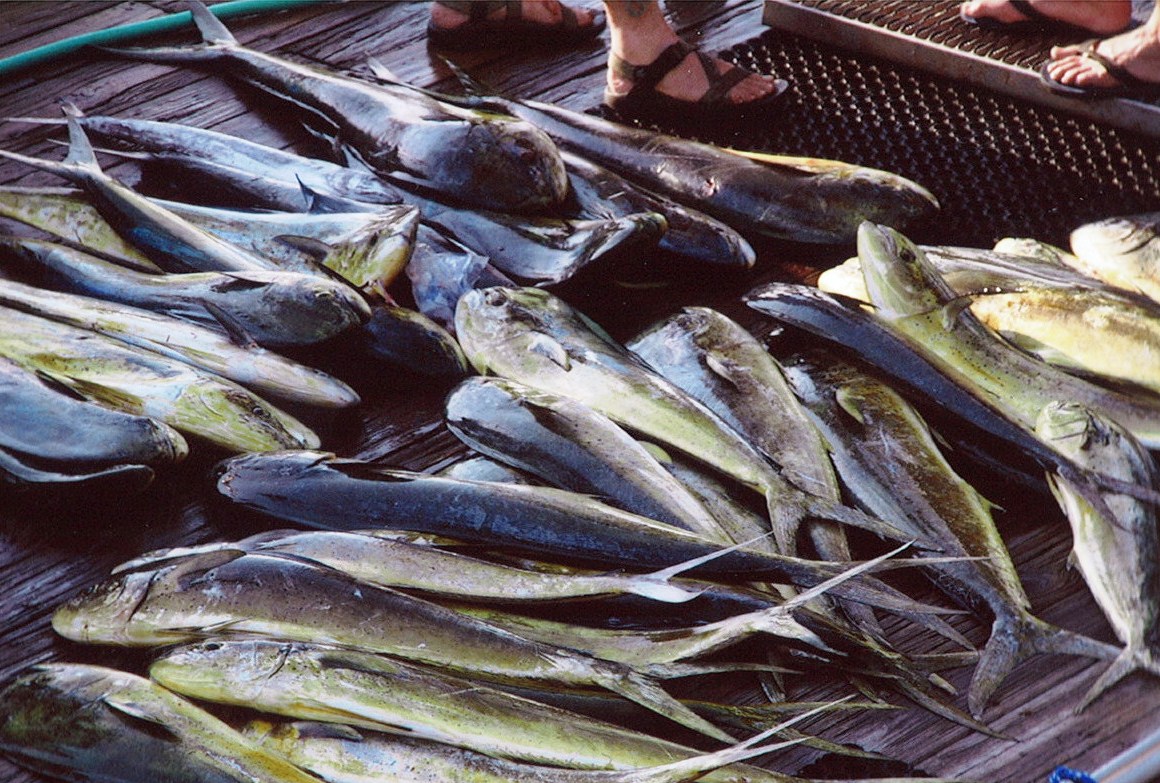
What is this? A floating dock full of Mahi Mahi also known as dolphin! Yep over 40 dolphins equaling 80 fillets possibly the makings for 300 fish plus tacos!
The Triple ledge had 3 fine ledges! There is lots of live bottom in between, which means drift fishing was always a possibility! Since I trolled and bottom fished with my customers this area provided me with an extremely target rich environment for catching fish. So therefore, I was a troller and bottom fisher! Most fishers that fished the blue water do so in search for what is considered top water fish. Here’s a few listed: Mahi Mahi, Wahoo, Tuna, and bill fish as well as other biters…
My theory, at least from my customer’s perspective, is that too much not getting a fish bite time makes for a boring fishing trip. So therefore, I came up with Captain Judy’s 15-minute rule! How does this work? Once I get the trolling spread out, after 15 minutes, and I get no interest it’s then time to troll over and do a little bottom catching. In my case, customers just want to catch something. Boiling down to the fact that they don’t want to spend a lot of time fishing and not catching.
So here is how I sold my blue water trips! I offered trolling or/and bottom fishing. Some customers wanted to do one or the other, which was fine with me. And then I had customers that just wanted to catch something. So, here’s how I accomplished this goal. I told my customers that they could bottom fish until they get tired of reeling and then I would troll. And this worked out most of the time, because about 3 hours of reeling in bottom fish was all they needed. (Much less could physically accomplish!) For about 15 years I did pretty good for my customers and I learned a bunch about fish that swim mostly in blue water.
Since I cut my teeth on the major bottom fishing scene, I had some grand catching luck when it came to this type of fishing. After explaining how to work the rod/reels I always told my customers that if you can get your bait to the bottom you are going to most likely catch a big fish. And most of the time we did catch a lot of big fish.
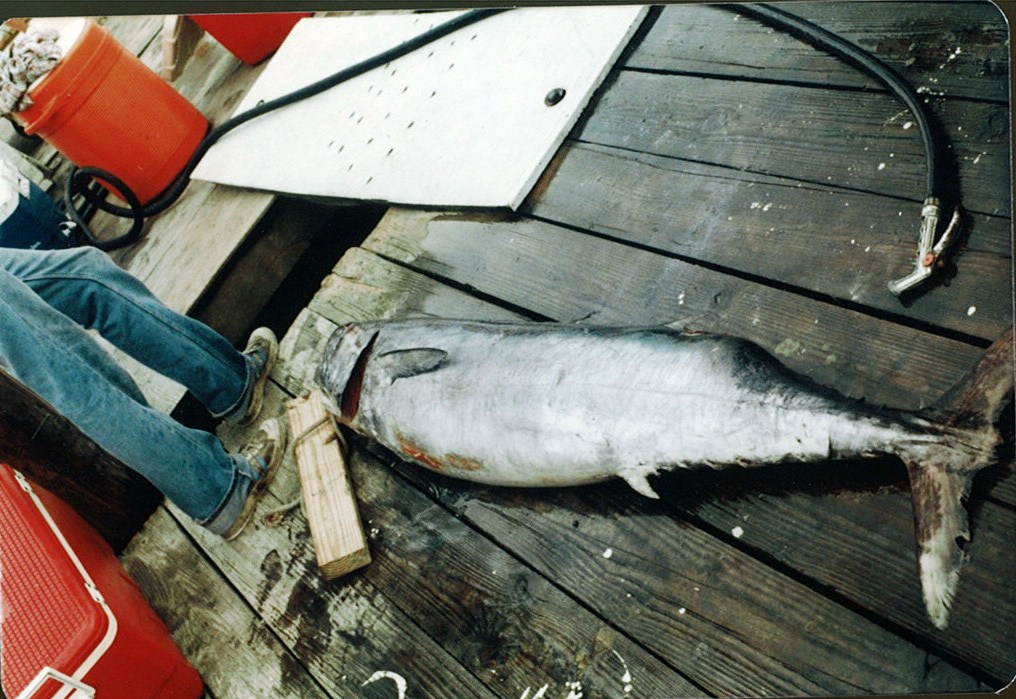
This is a Yahoo Wahoo that was caught on a flat line rigged with a live red porgy while drift fishing at the 944 Ledge! This fish weighed about 90 pounds and according to old blue water stories told, this fish is still growing in our heart and minds.
I used the same tactics as I did while fishing at the Snapper banks. So that you know, the Savannah Snapper banks area is about 25 to 35 miles off of the Wassaw Sea buoy. The blue water areas fished were located from 55 to 65 miles from the Sea buoy! Lots of riding took place after we passed the good old snapper banks!
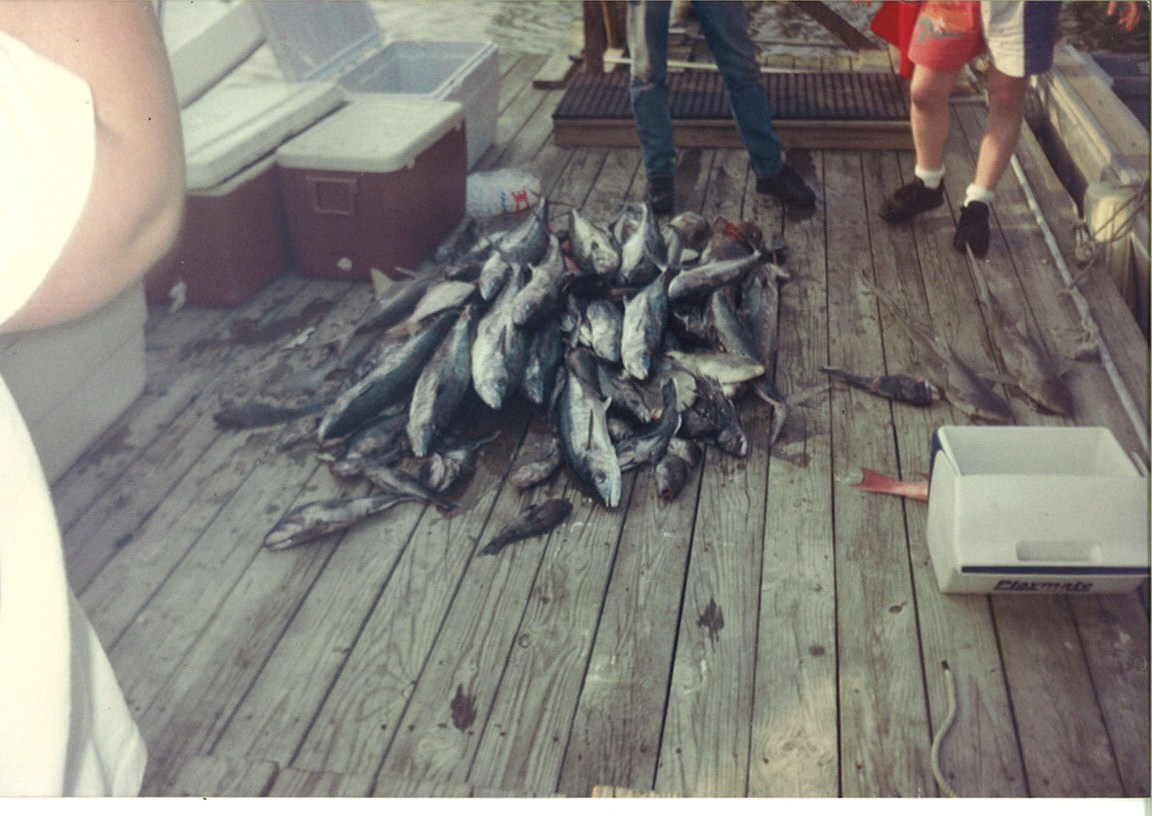
A normal day when bottom fishing and live lining at the B-Liner Hole! King mackerel, Mahi Mahi, Wahoo, black sea bass, triggerfish, Charleston snapper (red porgy) vermilion, sand tile, etc!
When I was young distance traveled was determined using this method. If we were heading east meaning to the fishing grounds, we had South Carolina on our left and Florida on our right. I learned quickly that South Carolina’s shoreline was protected greatly by offshore sand bars. So therefore, I never wanted to go to South Carolina while going or coming from the fishing grounds. And when we headed home or in a Westly direction South Carolina was to my right and Florida was to my left.
Now I know you must think all this is so crazy! However, when you are young (around 8 years old) and driving a big boat while your father is telling stories or just plain snoring up a storm in the forward berth, it is good to have a personal navigation formula to get you from point A to point B! Now that was a sincere mouth full of a sentence! Even though all this child navigation took place over 64 years ago I am still using the same formula. When I was heading home from the Triple Ledge here’s how I would gauge my progress. While heading home from triple ledge the first thing to pass was the R 3 naval tower, then the Bird, then the MR26 naval tower, then The Big Airplane, then the back of the snapper bank, then the mid snapper banks, then the front of the snapper banks, then the Anchor Ledge, then the L Buoy, Then the CCA Buoy, then the little airplane, then the Barnstable, then the German Submarine, then the old Texas Tower location, then the KC Buoy, then the AWOL wreck location, and then finally the W2 Wassaw Sea Buoy! It is a going out and in from the ocean kind of game that Daddy and I played for many years together….and now I am still doing it!
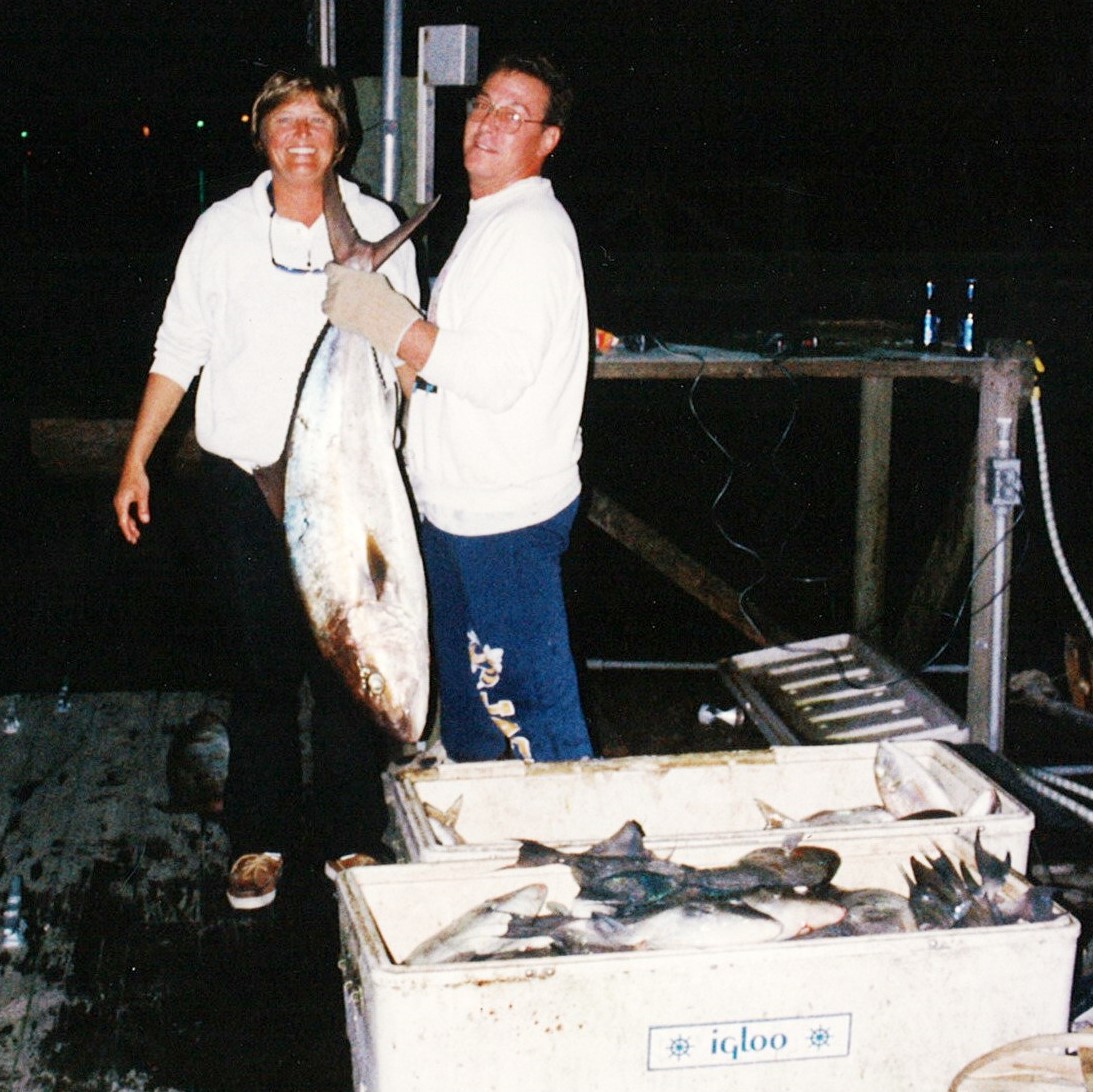
Believe it or not, this is our basic catch when bottom fishing at the gulf stream!
Captain Kathy Brown, my first mate, always asks, “Where are we?” And I always reply, “We are passing such and such!” And right off Kathy knows exactly how far we are either offshore or nearshore! I have been doing this so long that my customers know the game and use it to find out when they will arrive at the fishing grounds or back at the dock.
And I also need to add during the eight years old navigation days, daddy tied a string on the boat ship’s wheel spoke that meant the rudder was straight. Now here’s the thing about this situation, if you turned the wheel completely one turn, your rudder position would be out of Wack. Why? Well, one complete turn of the ship’s wheel meant the boat would start circling either to the starboard or the port. Believe me, my father didn’t like this mode. My goal was to maintain a heading by steering no more than 3 spokes starboard or port. The reason being is that if I turn more one way or the other, I would be confused and start circling.
I know I am rambling…so I will get back to the story at hand. The Triple Ledge is one of those areas that seems to always hold the interest of some sort of fish. In the early and late spring Mahi Mahi and tuna love this area. These fish found the ledges a grand target rich environment for putting on the old feed bag. In my case, since I was a troller and a bottom fisher, I could have stayed in this one area all day and had plenty of action for sure. If the water temperature to the west of the stream was cooler, the best blue water bites can happen. Why? This means there is still a temperature edge!
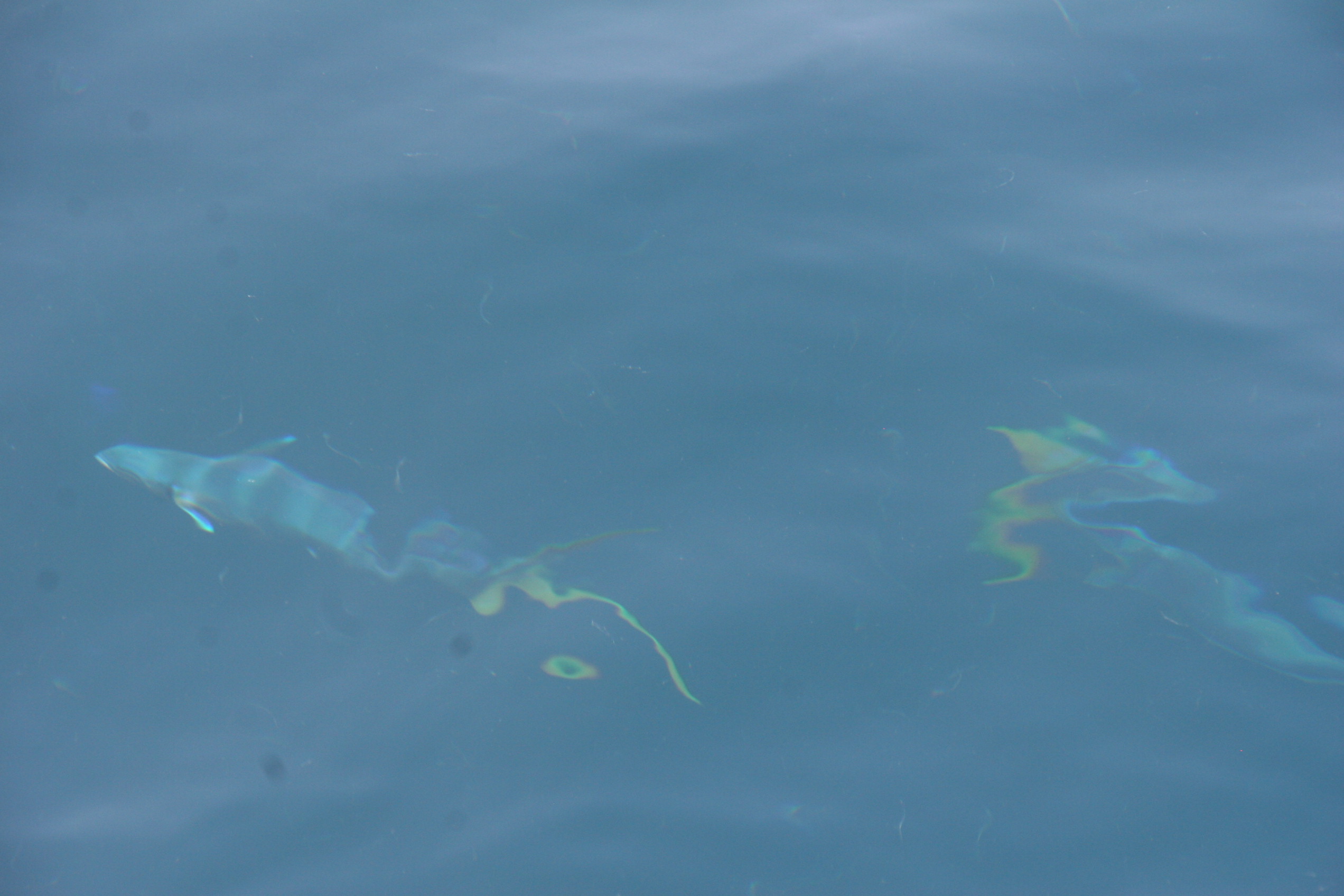
Mahi Mahi with their feeding lights ON! What does this mean? I am hungry! Feed me, I will eat!
What’s the big deal about an edge? An edge is formed when two currents having different water temps collide! Smaller fish, also known as prey, are pushed, and drawn to it. It seems like a haven to a smaller fish. Larger fish, also known as predators, go there to feed because it truly is a target rich environment offering a lot of serious feeding opportunities. When the warm waters of the stream along with formed fingers over or around the triple ledge it is a very good thing for the fish and the fishermen!
What is a finger of the stream? I thought you would never ask! They are pockets of water that separate from the stream and then push west. The finger is still connected to the stream, which allows all sizes of fish to start making way. The finger has two edges, and its current flows counterclockwise. The water in the finger moves slower than the stream, which runs a steady northerly 3.8 knots. Therefore, prey and predator find the fingers have lighter moving current meaning less turbulence offering each more energy to stage as well as feed.
It has been said and I have heard this all my fishing life that “The blue water lights go out in Georgia at the end of June!” What is this supposed to mean? Water temperatures in the stream and waters to the west were the same taking the prime fishing arenas away until the late fall temp drop. Why? The area widens and blue water fish along with the bait that they chase spreads out. So, this is the time that green water fishermen get there a grand opportunity to hook up a billfish. Well, you must know I certainly didn’t stop fishing just because the so call lights in Georgia dimmed. Heck, I still had customers that wanted to take the long ride to the blue water fish! And I loved that for sure!
To get this situation to work for me I had to make some interesting changes. When the trolling faded the top water bite was pretty much closed. So, I decided to do what I do best, which is start bottom fishing and keeping a so called a top water aka flat line out. The bottom during this time of the year was in the Wide-Open biting mode. If you could get your bait to the bottom you were going to most likely catch a pretty big fish. And while all of this was going on I would put out a top water line baited with a large ballyhoo or live bait fish. The old ballyhoo when fished on a flat line close to the surface puts off a lot of shine! When the sun rays hit the shiny scales of the Hoo it sends mirror type signals. The ballyhoo shine is head turner for a fast-moving fish.
When it came to live bait such as vermilion snapper or ruby red lips, they worked great. However, the standard light wire king mackerel rig couldn’t and didn’t hold up to aggressive hits that a big Wahoo delivered on impact. Just like a large smoker king a Wahoo’s teeth did lot of cutting damage. Quite often delivering a hit so quick that the reel never even whispered a touch had been had. So therefore, I started experimenting with heavier single strand wire and larger extra strong treble hooks as stingers. And I started using medium size red porgy as my live bait. This is a hardy bait, which can swim easily at different depths in the water column with little air bladder filling effect. The big Wahoo loved this bait presentation and followed suit by ripping off hundreds of yards of line before the person holding the rod could get situated! In other words, it’s the perfect get your heart beating and your blood pumping situation!
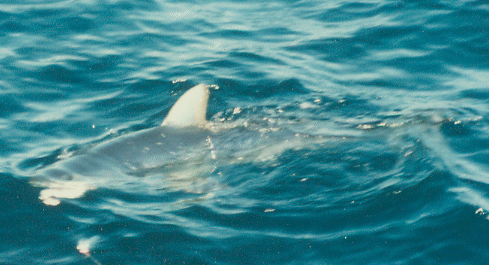
Mako Shark! What are these famous once hooked up? Jumping, Jumping, and jumping! We fought this shark for almost 3 hours! Why? This Mako shark hit a light tackle king mackerel rig, which was being fished on 20-pound test monofilament main line. So therefore, the angler had to do lots of reeling and the captain (Captain Judy) had to do much maneuvering with the boat. The line broke leaving us sad, but to be honest, I didn’t exactly know how to boat this monster. This was my first Mako and knowing what my father told me I was aware that handling this fish certainly could be dangerous!
Sharks on the prowl!
When the blue water bite lights go out in Georgia (end of June) big sharks can be found touring the underwater mountains at the Triple Ledge. The simple fact of the matter is if you wanted to make a pass during this time, I suggest pulling your trolling spread in. Why? The downside is that many sharks will hit and take out your entire trolling spread out. They work like a tag team by delivering lots of line cutting and lure hitting mayhem! The upside is, if you are looking to hook up a big shark, give it a pass through with trolling baits out! Be aware if you have 4 bait outs you will hook up 4 sharks. If you have 6 lines out, you will most likely hook up six sharks. And some might be hooked together and so on!
I will never forget the first time this happened to me. As I approached the Triple Ledge area I watched as many wakes were headed my way. The closer I got the faster they moved. Not one or two wakes but many. At first, my thought was, “How cool it this?” I screamed, “Incoming!” and sure enough, our spread was taken over by at least 5 big sharks of assorted sizes and types. At the time I thought this was going to be a single occurrence. Well, I was wrong, the sharks were in attack mode on your approach, just about every time, especially after the month of June! Heck, I would have hated to be swimming in this area. So, after I got this through my hard head and after many expensive trolling lure losses, I got it!
I learned the hard way not to pull over the Triple Ledges after the month of June. However, if it was a slow day and I needed some action, well I knew exactly what to do! Leave the lines out, make a grand pass, and wake my customers up!
Do I think this is still happening? I certainly do think so! It is your turn to give this area a pass by try!
Thanks for reading!
Captain Judy Out!
